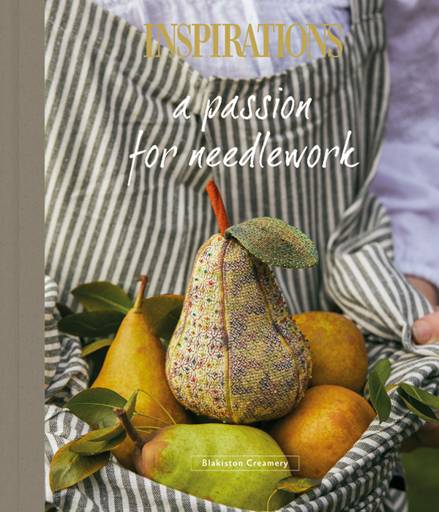Woodland Floor by Helen M. Stevens
29TH JANUARY 2021 - ASU #267
Woodland Floor by Helen M. Stevens from our book A Passion for Needlework | Blakiston Creamery is a striking botanical study worked in shimmering silks on a dramatic black background.
As well as periwinkle flowers and dandelion leaves, the piece features a purple emperor butterfly, a painted lady butterfly and a gently hovering bumble bee who introduces a splash of brilliant colour into this already eye-catching piece.

Now, another way of writing that last sentence you just read would be to say: ‘As well as Vinca minor and Taraxacum officianale, the piece features Apatura iris, Vanessa kershawi and a gently hovering Bombus locurum…’

Although all members of the plant and insect family represented in Helen’s Woodland Floor have common names which almost everyone knows, it is easy to forget that they all carry scientific names too, many of which are far more elegant and poetic than the common titles.
We certainly felt that the majesty of Helen’s design was enhanced by a knowledge of the proper scientific names.

But where do those names come from and what do they mean? Why does each have two words and why is it conventional for the first to be capitalised? These are questions which anyone who has studied biology might know the answer to, however, as it’s been a while since we attended high school, they piqued our curiosity.

The poetic names of Helen’s insects and flowers are part of the binomial nomenclature (or two-term naming system) which is common in scientific circles. The first part of the name, or the capitalized section, refers to the genus to which the species belongs.
The second part of the name identifies the species within the genus. So, for our purple emperor, he is part of the group apatura (which contains, out of interest, four species) and his personal identifier is iris.

The words themselves arise in all kinds of ways. The most common is from Latin, but names also derive from people, places or other languages. Similarly, the second part of the binomial can be an adjective or a noun, treated grammatically as a Latin word. That noun may also be formed from a name, a description or a place.

Knowing where the names come from, it almost seems sad that we don’t always refer to each individual plant or insect by its elegant binomial. Just as rendering them in silk in exquisite detail like Helen has done in Woodland Floor lifts these creatures up from the mundane and every day, so referring to them by their proper binomial seems to elevate them beyond the ordinary.

It would be inaccurate to label any of Helen’s designs as ‘ordinary’ just as it would be wrong to believe any of our own stitching is ordinary. Each design is something special, and every time one of us creates a stitched piece, we too are creating something unique.
Bearing that in mind, perhaps as you select each strand of silk, and work each element of this magnificent project you can reflect on the name it carries and what it means. It will just help to reinforce how unique each member of the animal kingdom is, just as is each creative endeavour we undertake.
Make Your Own Woodland Floor

Step 1 – Purchase Project Instructions
Woodland Floor by Helen M. Stevens from the book A Passion for Needlework | Blakiston Creamery is an enchanting woodland scene captured using lustrous filament silk threads.

Printed Book
A Passion for Needlework 3 | Blakiston Creamery
Shop NowStep 2 – Purchase Ready-To-Stitch Kit
The Inspirations Ready-To-Stitch kit for Woodland Floor includes everything* you need to re-create this charming scene: Fabric (unprinted), dressmaker’s carbon, embroidery threads and needles.

Kit
Woodland Floor - APFN3 Kit
Shop Now*Please Note: To cater for flexibility of purchase, instructions are not included with our kits. For step-by-step directions on how to create this project, please refer to the book.
